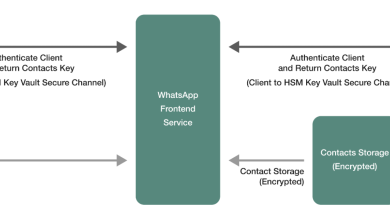Klaviyo vs Mailchimp: The Ultimate Comparison

Klaviyo vs. Mailchimp: Which solution is really best for your email marketing campaigns?
While today’s companies have countless ways to connect with their audience, from webinars to social media posts and videos, the power of email simply can’t be overlooked. Email is still one of the most valuable ways to connect with and nurture customers. It’s also one of the most cost-effective marketing solutions, delivering an average $40 return for every $1 spent.
Of course, managing endless emails on your own would be a time-consuming and complex process. That’s why email marketing platforms like Klaviyo and MailChimp exist.
These compelling platforms provide everything business leaders, creators, and entrepreneurs need to create powerful, professional, and automated campaigns. With the right platform, you can nurture customers, connect with clients after transactions, and even reduce abandoned cart rates.
The question is, which email marketing solution is best?
Today, we’re taking a closer look at the features and benefits of the Klaviyo email marketing platform and the Mailchimp email marketing solution.
Both of these tools have an excellent reputation, promising everything from easy-to-use templates to insightful analytics and valuable automation tools.
Let’s dive into the comparison.
Klaviyo vs. MailChimp: An Overview
Both Klaviyo and MailChimp offer a lot of overlapping features and functionality. They’ll both allow companies to set up strategic email campaigns, automate customer communication, and drive new sales. However, each solution takes a slightly different approach.
Today, we’re going to be looking at the following points to help you determine whether Klaviyo or MailChimp is right for you:
- Features: While both Klaviyo and MailChimp offer similar features, Klaviyo’s tools are slightly more in-depth in terms of customization, segmentation, automation, analytics, and reports. MailChimp’s solutions are easier to use but less customizable.
- Pricing: Both Klaviyo and MailChimp offer access to a free plan. However, MailChimp has a wider range of affordable premium plans to choose from for growing brands.
- Ease of use: Klaviyo has a lot more features to explore than MailChimp, so getting used to the service can be a little overwhelming, though there is plenty of guidance. MailChimp is a little more straightforward but less advanced in some areas.
- Integration: Both Klaviyo and MailChimp offer integrations with a wide range of website builders, CRMs, and other tools. They also can connect with Zapier.
- Customer support: Both Klaviyo and MailChimp offer email and chat support; however, Mailchimp has more advanced social media support, while Klaviyo offers a more comprehensive knowledge base.
Klaviyo vs MailChimp: Features Comparison
Let’s start with an overview of some of the most important features you can access on both Klaviyo and MailChimp.
Klaviyo vs. MailChimp: Email Campaigns
If you’re looking for the ultimate email marketing tool, the first thing you’re going to want to examine on both platforms is the email campaign options. Both tools come with a visual campaign builder to help you make the most out of your marketing strategy. You can drag and drop everything from buttons to products into your emails and customize them however you choose.
Both platforms will allow you to create:
- Transactional emails: You can use both Klaviyo and Email to send order notifications and confirmations to customers. You’ll need to contact the customer service team with Klaviyo to send a transactional email, however, which can be a little tricky.
- Abandoned cart messages: Both Klaviyo and MailChimp allow you to create email campaigns specifically designed to draw customers back to their shopping cart if they leave without making a purchase, complete with links to products.
- Product recommendations: Both MailChimp and Klaviyo can leverage segmentation information from your accounts to deliver personalized recommendations to customers.
- Personalized email flows: With both of these tools, you’ll be able to create personalized email flows for specific customers in your target audience. You can also set up specific times for emails to be delivered based on what you know about your audience.
Mailchimp Email Campaigns
When you log into your MailChimp account, you can either create an email by clicking on the “Create” button or selecting the “email templates” option. Clicking on “Create” will take you to a page where you can choose what type of campaign you want to build:
Clicking on the “Regular Email” option will take you to the email builder page, where you can choose between using the classic email builder or the new AI-enhanced email builder, available in beta mode. Once you select your option, you’ll be able to select from a range of templates or code your own template from scratch with the AI assistant.
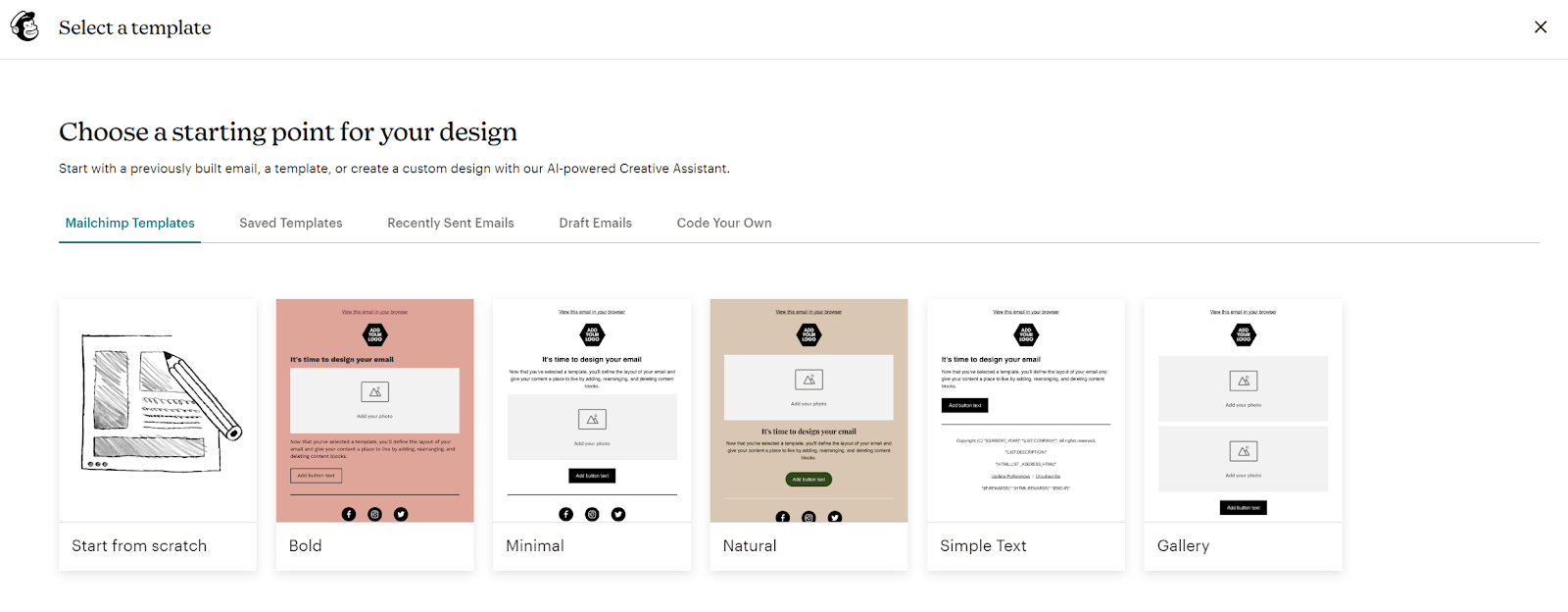
Once you’re in the builder, you can simply drag and drop the components you want into your campaign. Options include everything from buttons and headings to dividers, logos, social media sharing buttons, surveys, and products.
You can also choose from a range of styles for different parts of your email campaign and preview what they’ll look like in both desktop and mobile formats.
Klaviyo email campaigns
Creating a campaign in Klaviyo requires you to click through to the “Campaigns” tab on your email dashboard. Here, you’ll be able to choose whether you want to switch to the new email editor or stick with the classic editor. You can also set up a calendar for your campaigns.
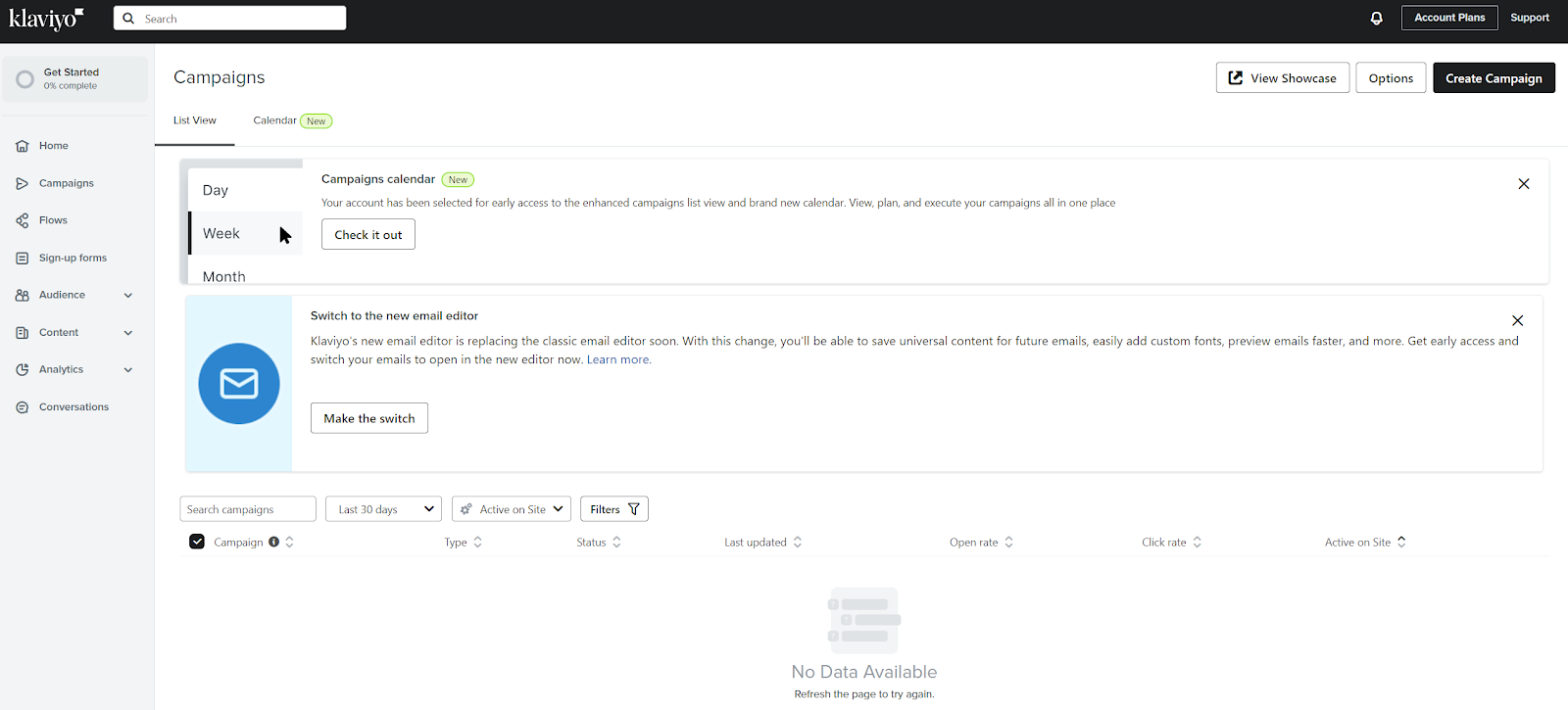
Clicking on “Create Campaign” in the top right corner will allow you to choose whether you want to create push messages, SMS, or an email series. Once you choose your campaign, you can click on the “Content” section on the right of the screen to choose a template for one of your emails.
There are various template options to choose from, all for different use cases. Most of the options are relatively simplistic and straightforward, allowing you to add your own branding and elements.
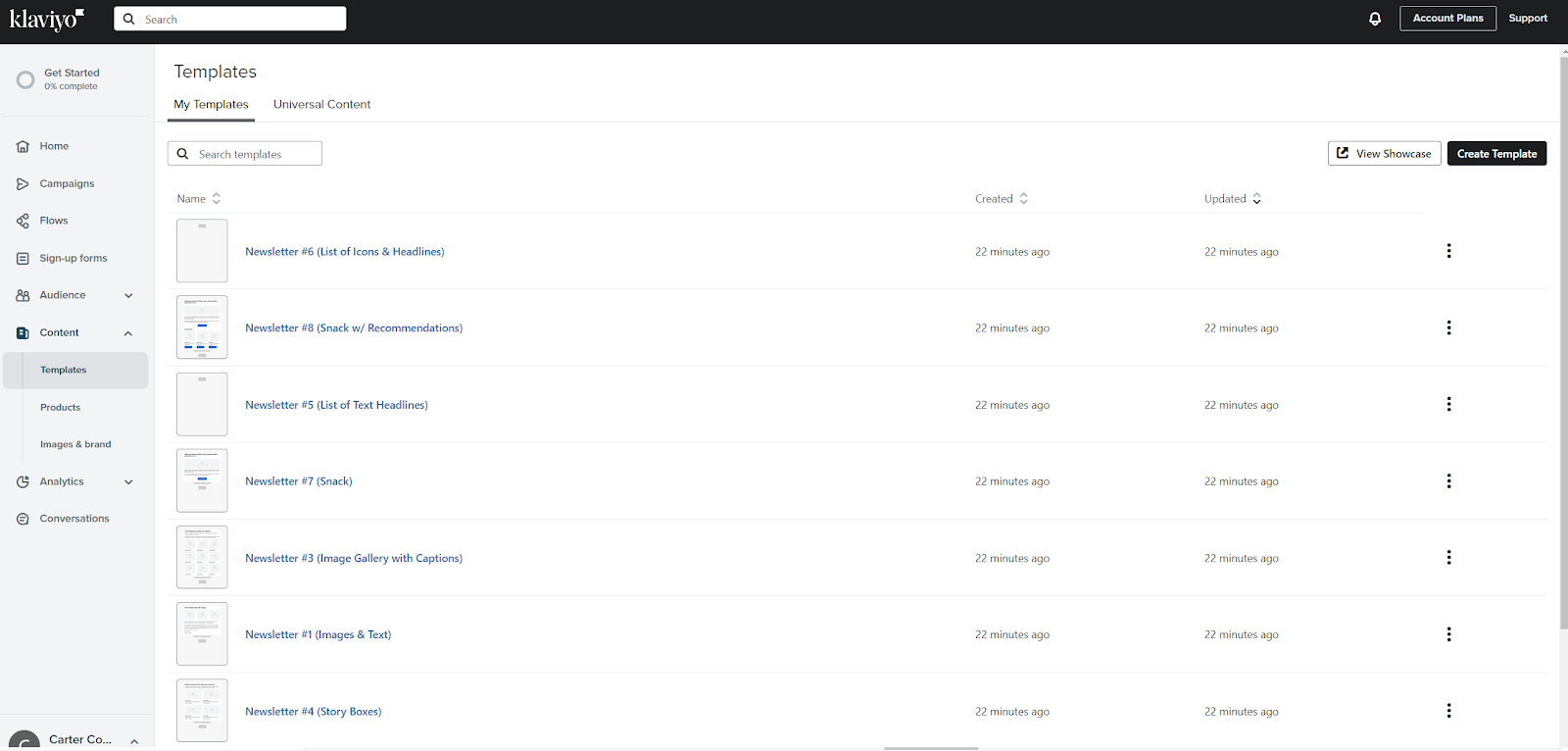
Clicking on a template will take you to the email builder, which is similar in style to the visual editor from MailChimp. You’ll see a preview of your email on the right and a list of content blocks you can add on the left. You can also preview your campaigns in mobile and desktop format and change the style whenever you like.

Klaviyo vs MailChimp: Automation
78% of media planners are currently leveraging automation to improve business performance and enhance customer experience. Automation is available on both Klaviyo and MailChimp to help you build personalized drip campaigns for a range of use cases.
MailChimp Automation
Creating an automated email series on MailChimp is extremely straightforward. All you need to do is go back into the “Create” menu and click on the “Automation” option. When you click the “Create Journey” button, you’ll be able to choose whether you want to design an automation flow from scratch or select from a range of popular pre-built journeys.
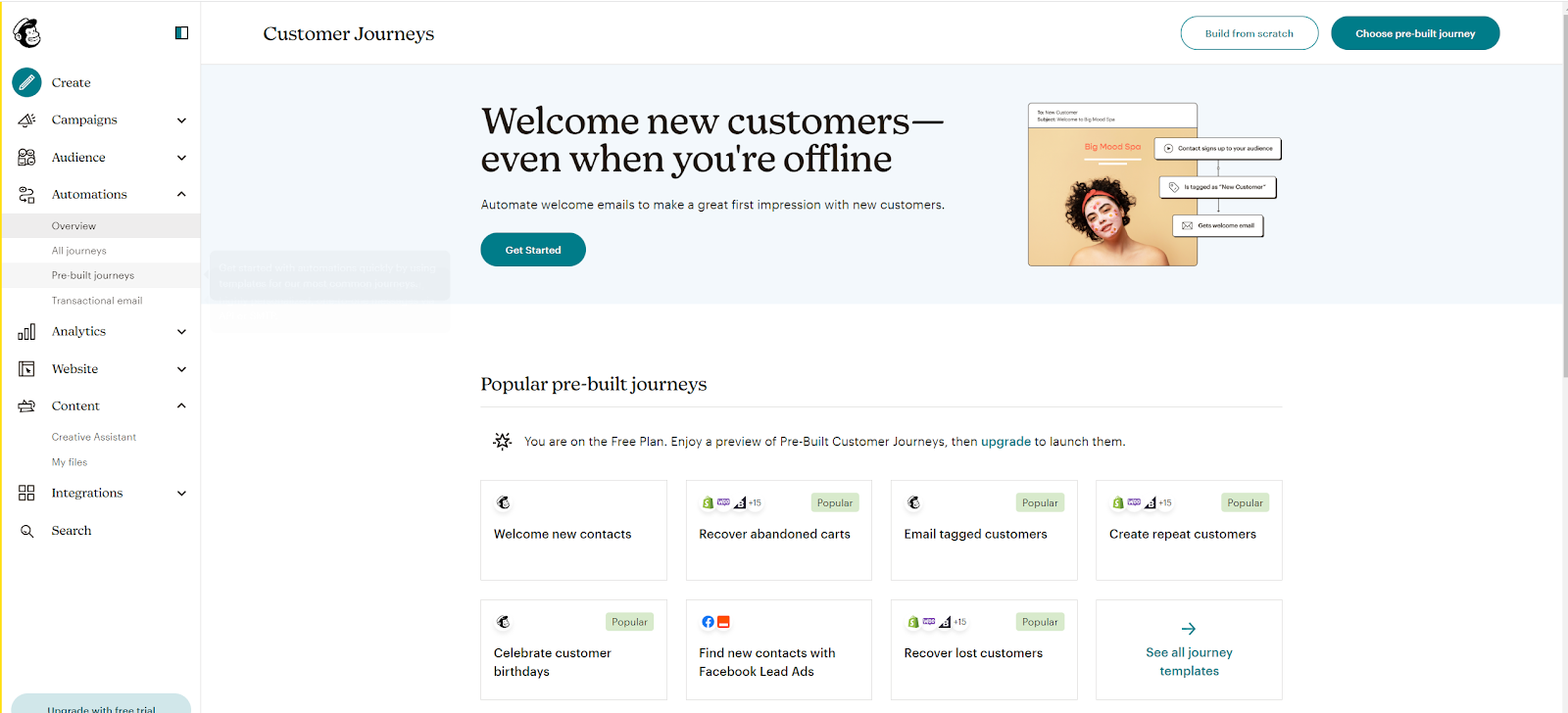
Click on one of the pre-built options, and you’ll be taken to a simple page where you can decide which triggers you want to use to send emails to your customers. The visual journey builder is very easy to use, with the option to add and remove triggers and actions wherever you like.

The Customer Journey Builder built into the MailChimp environment ensures you’ll be able to create email campaigns for virtually every interaction you have with customers. You can create event-based automation that allows you to send messages for product retargeting campaigns, recommendations, and abandoned carts. Plus, you can send automated emails for welcome messages and birthdays too.
Klaviyo Automation
Klaviyo offers all of the same automation options you’ll have on MailChimp. You can send behavioral-trigger emails, personalized messages based on customer profiles, and even track attribution rates. Klaviyo uses the basic trigger flow mechanism to automate emails, allowing companies to choose exactly which action should lead to an email message.
To create an automation journey within Klaviyo, you’ll need to click on the “Flows” section of the dashboard. You can choose from a range of pre-built flow options within the Klaviyo library, or you can design a flow from scratch.
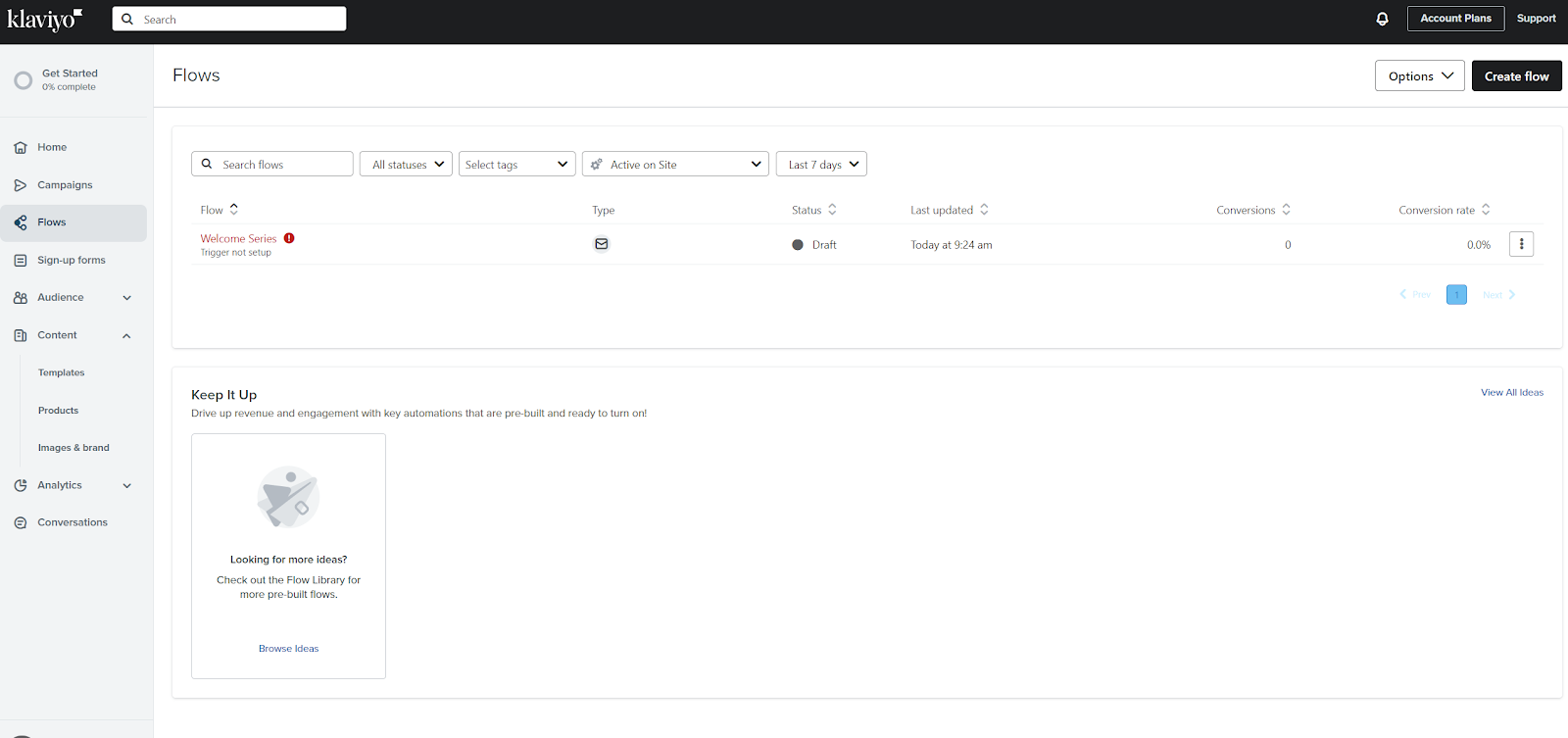
When you choose a flow, you’ll be asked to choose the specific list of customers you want to send your emails to, making personalization simple. You can then use the simple editor to set up logic, timing, and content for each automated campaign.
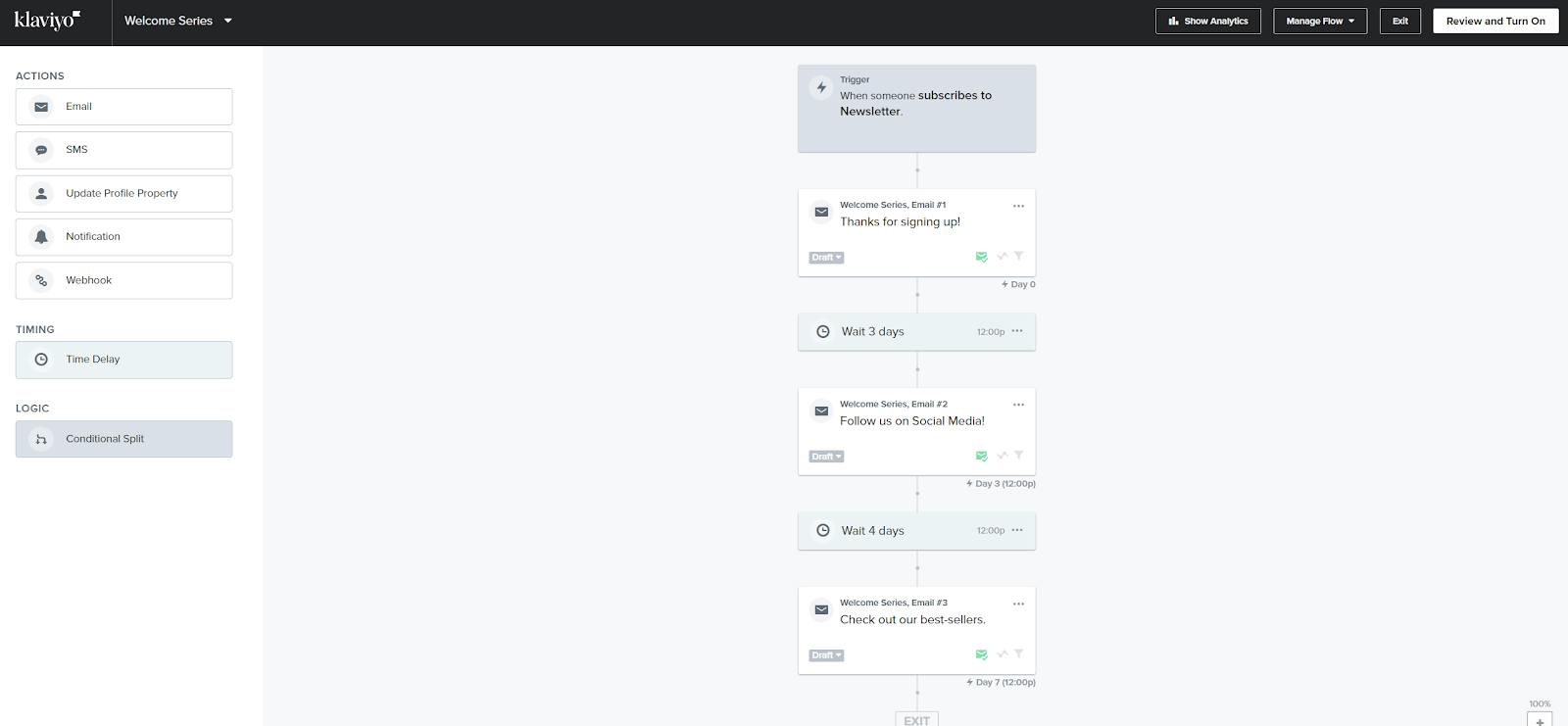
Klaviyo’s flow builder is a little more comprehensive than MailChimp’s. It gives you the option to set up conditional splits, implement different types of messages (such as SMS), and even connect webhooks throughout the customer journey.
Like MailChimp, Klaviyo gives you a huge range of automation options to take advantage of, from prompt emails when a product comes back in stock to real-time order and shipping updates and welcome series emails.
Klaviyo vs. MailChimp: Segmentation
Segmentation is perhaps the most important tool any business can use to ensure they’re getting the most out of their email marketing strategies. Segmenting your audience means you can deliver more personalized campaigns to each customer based on their specific interests or needs.
Fortunately, both Klaviyo and MailChimp make segmentation relatively easy.
Mailchimp Segmentation
Clicking into the “Audience” section on your MailChimp dashboard will allow you to explore all of your contacts, create sign-up forms, and even assign tags to specific customers. The “Segments” section gives you the power to create segments by location, engagement, activity, and more.
The great thing about MailChimp’s segmentation features is they make it easy for beginners to get started. There are pre-built segment suggestions available based on purchase history, new subscribers, activity levels, and so on. You can even use analytics to track subscriber preferences and segment them based on their email behaviors.

Thanks to its new AI features, MailChimp can even predict the demographics of your contacts to help you define which customers should be included in which groups.
Klaviyo Segmentation
Klaviyo also takes segmentation seriously. When you click into the “Audience” section of your dashboard, you’ll be able to access both lists and segments, as well as customer profiles. Profiles can be particularly useful if you want to collect specific information about VIP customers.
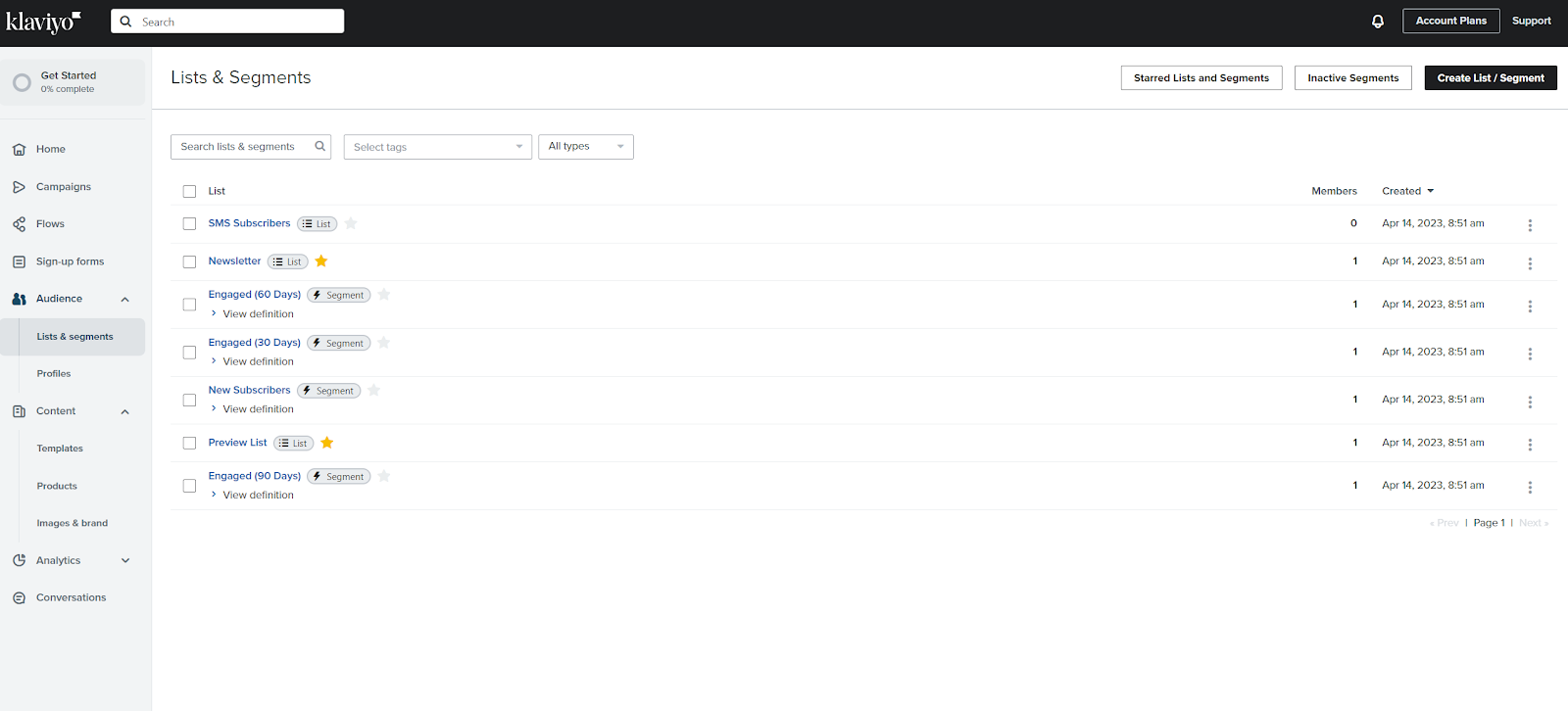
Klaviyo also gives you suggestions on how to segment your audience based on their engagement levels and behavior. You can segment by transactional data, demographics, and more. Plus, you can combine different conditions for various segments to create extremely personalized campaigns.
There’s even the possibility of creating segments for SMS and email subscribers at the same time. When you create a segment on Klaviyo, you can also set up an automated system that adds new customers to the list when they complete an action, such as buying a certain product.
Klaviyo vs. MailChimp: A/B Testing
If you need help optimizing your campaigns, A/B testing can come in handy. Both Klaviyo and MailChimp give you the option to monitor the success of a campaign and track its performance compared to other variants. However, MailChimp’s testing options are a bit more simplistic.
With both tools, you can test things like:
- From name
- Content
- Subject line
- Send time
However, you may not have full access to the A/B testing options if you’re on a free plan with MailChimp. Klaviyo allows you to go a little further with you’re A/B testing strategy by allowing you to check the performance of different flows and campaigns rather than individual emails.
You can also configure more settings to help you decide which campaign is the “winner” for your analysis, looking at things like open rate, conversion rate, and click rate. However, setting up an A/B test on Klaviyo is a little more complex. You’ll need to create your campaigns separately first, then click on the “Create A/B test” option at the bottom of the page.

On the plus side, A/B testing is an option on Klaviyo’s free plan.
Klaviyo vs. MailChimp: Analytics and Reporting
A/B tests aren’t the only way to get a behind-the-scenes insight into your campaign’s performance.
Both Klaviyo and MailChimp also give you access to a variety of useful analytics and reporting features too. These allow you to track critical metrics like open rate or gather information about your preferred target audience.
Mailchimp Analytics and Reporting
The MailChimp reporting features are conveniently located in the “Analytics” tab on your dashboard. You can choose between “Email,” “Reports,” or “Custom Reports” to examine crucial information. Clicking on “Email” will take you to a page where you can create a custom dashboard showcasing your most valuable information, such as the number of orders, average order revenue, and click rate.
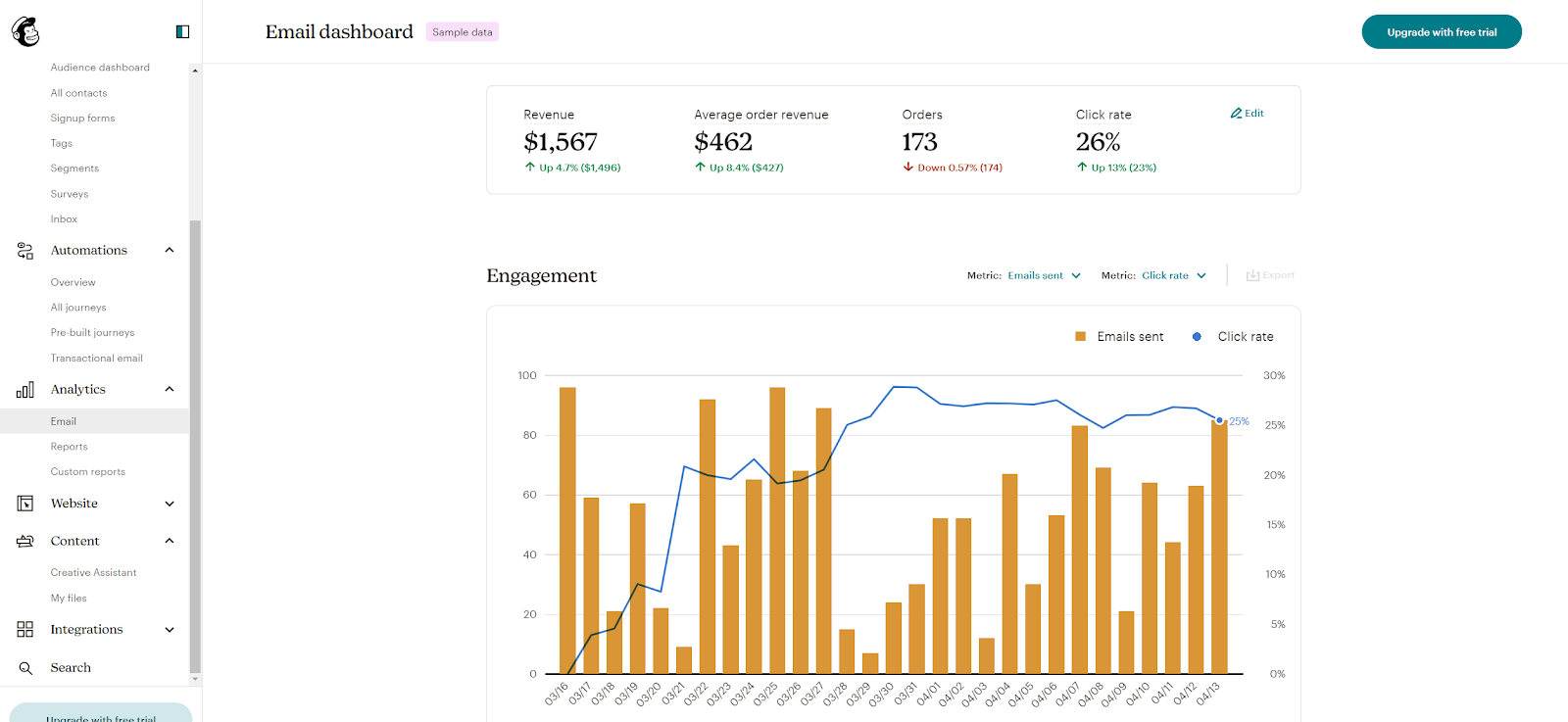
You can also examine analytics based on a specific time frame or compare your results from one month to another. The visual insights are beautifully straightforward and easy to understand. Plus, each report can be exported to share with your team members. To create more comprehensive reports with real-time analytics of your email campaigns, you can connect Mailchimp to Looker Studio.
Clicking into the “Reports” section will allow you to dive a little deeper into the performance metrics of each individual email or SMS campaign. You can also gather insights into the results of your landing pages, custom ads, social posts, surveys, automation, and even physical postcards.
It’s also worth noting MailChimp has its own handy “Contacts” section where you can collect information about your target audience and see whether customers have a low, high, or medium estimated lifetime value. Predictive analytics gives you a behind-the-scenes view into how much value each potential customer can bring to your brand.
Klaviyo Analytics and Reporting
Klaviyo also has some fantastic reporting and analytics features. First, in the Audience section of the dashboard, you can create a detailed profile for each customer, complete with insights into their purchase history and past interactions with your content. Using predictive analytics, Klaviyo also gives you estimated projections of each customer’s expected lifetime value.
In the “Analytics” tab, you’ll find dashboards, metrics, benchmarks, and custom reports. Similar to the MailChimp dashboard, the dashboard option allows you to track visual data about your customers based on a specific timeframe and crucial key performance indicators.
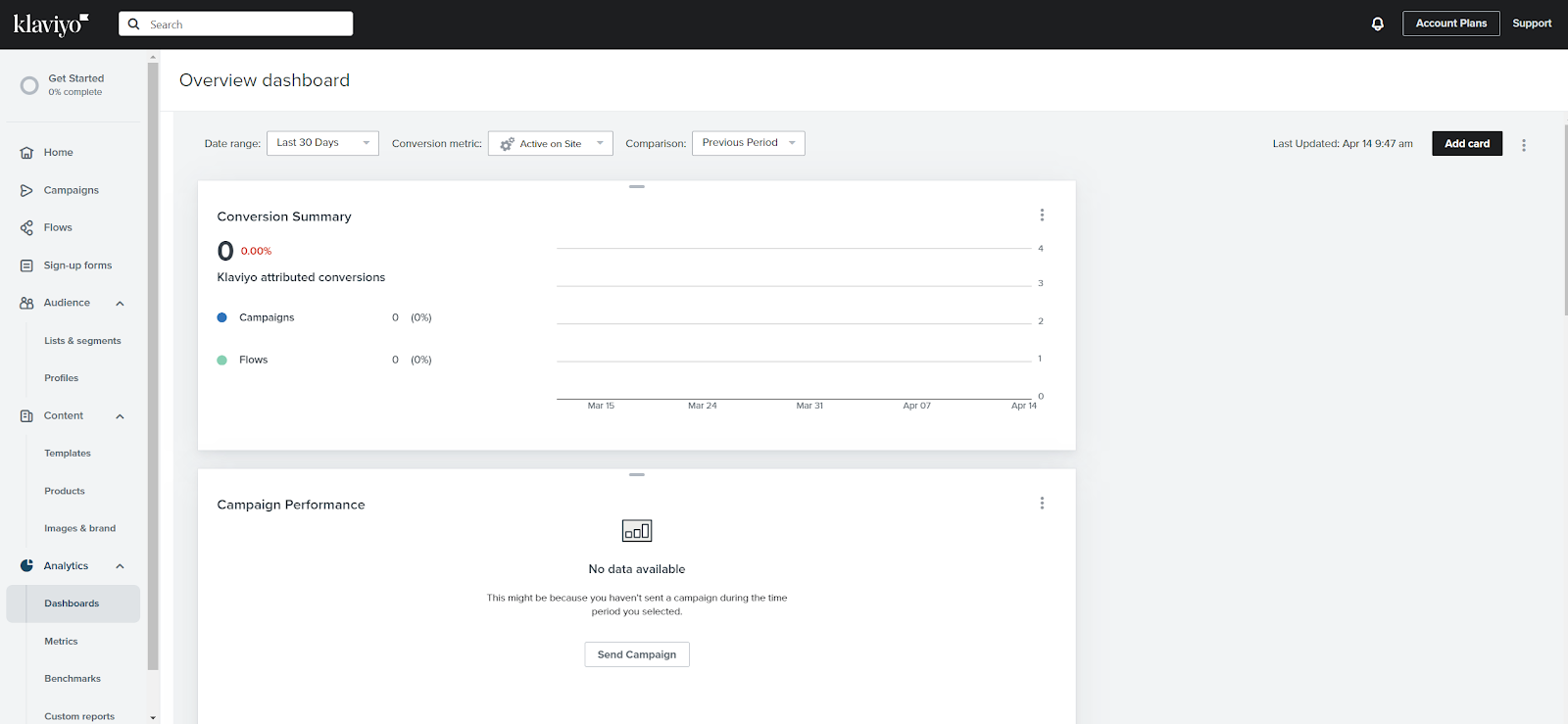
You can customize your dashboard however you choose to ensure you’re tracking the metrics most relevant to your company. Clicking into the “Metrics” section will take you to a comprehensive page where you can monitor countless crucial performance indicators, from bounced emails to clicked email rates. There are far more metrics available to monitor here than you’d find on MailChimp.
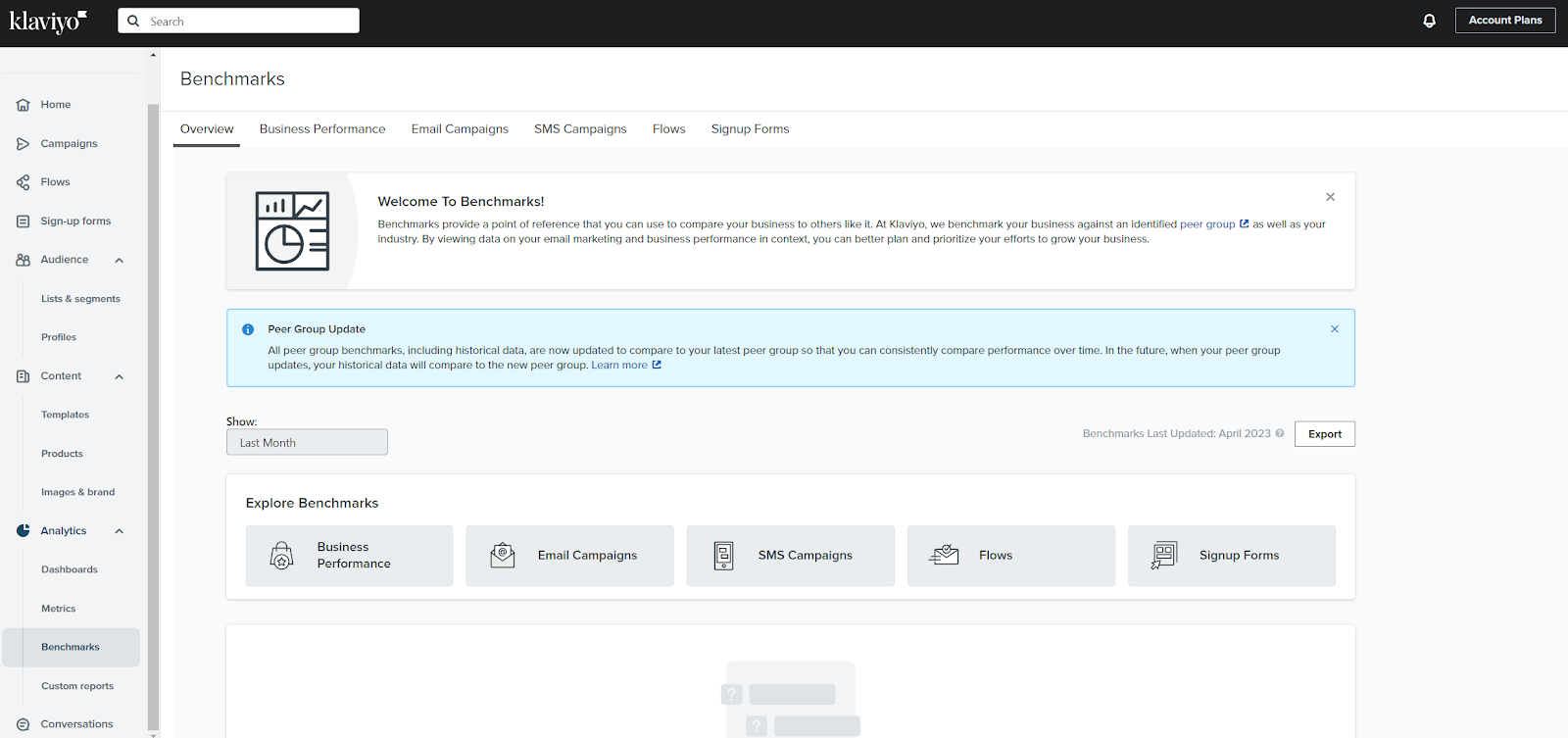
Klaviyo also gives you the opportunity to compare the performance of your campaigns to benchmarks for your industry using market data. This is extremely helpful if you want to determine whether your campaigns are really paying off.
As with MailChimp, you can also create and export custom reports for your shareholders and team members using visual graphs and data representations.
Klaviyo vs. MailChimp: Pricing
One of the main things to keep in mind when choosing between Klaviyo email marketing and MailChimp, is the two options offer very different pricing models.
Mailchimp Pricing plans
Mailchimp is a much more affordable option for companies looking to set up drip campaigns and email sequences. There’s a comprehensive free plan available, which allows users to send up to 1000 emails to 500 contacts per month. However, it doesn’t include automated customer journeys, A/B testing, email scheduling, or customer support. All of your emails will also include MailChimp branding on the free plan.
The tiered pricing system gives you access to different features on each level, and the prices vary depending on your plan and your number of contacts.
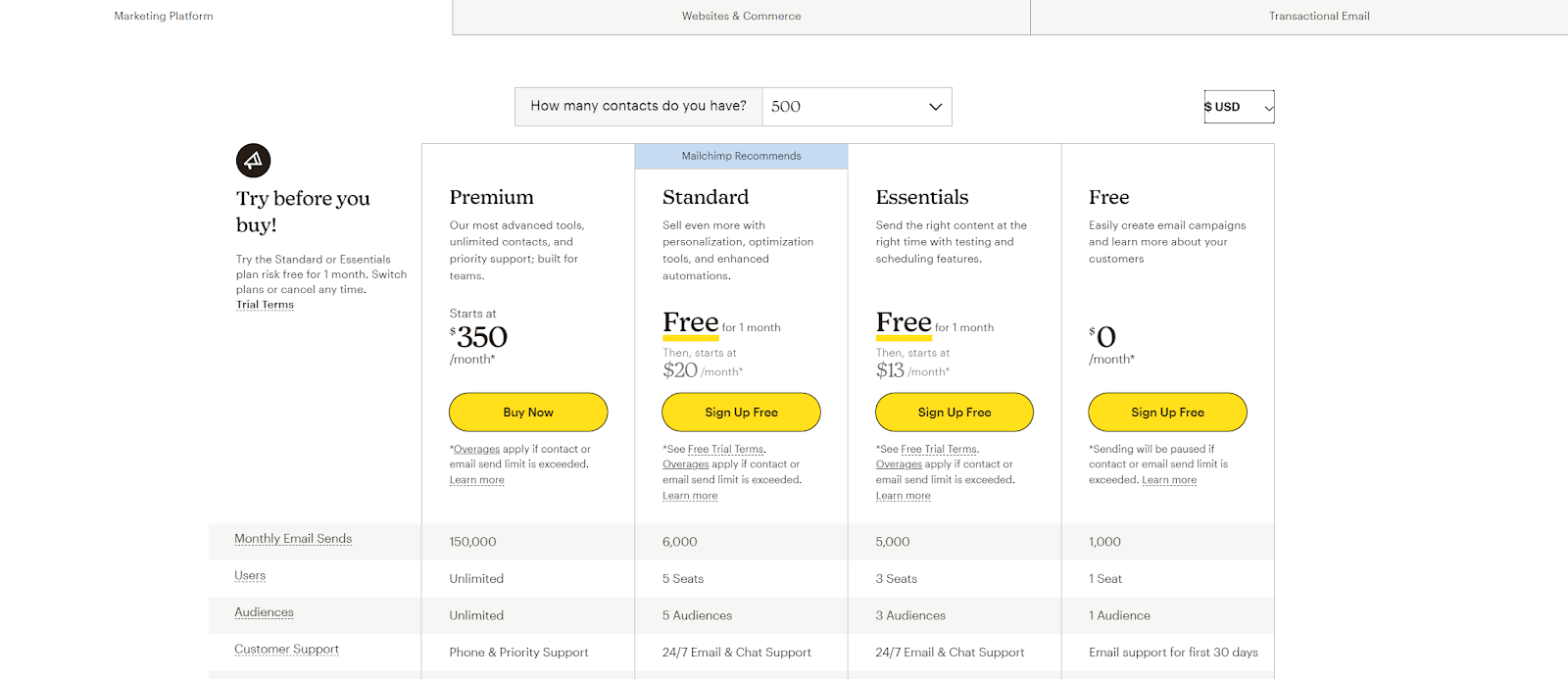
Options outside of the free plan include:
- Essentials: Starting at $13 per month for up to 500 contacts, with 5,000 monthly emails, 3 seats, 3 audiences, 24/7 chat and email support, pre-built templates, assisted onboarding, 2 role-based accounts, automated customer journeys, email scheduling, A/B testing, and no MailChimp branding.
- Standard: Starting at $20 per month for 500 contacts, with all the features of Essentials, plus 6000 monthly emails, 5 seats, 5 audiences, 4 role-based accounts, enhanced customer journeys, custom-code templates, predictive segmentation, content optimization, dynamic content, campaign management, and send-time optimization.
- Premium: Starting at $350 per month for 500 contacts, with all the features of Standard, plus 150,000 email sends, unlimited users and audiences, priority support, 5 role-based accounts, dedicated onboarding, advanced segmentation, and multivariate testing and comparative reporting options.
Klaviyo Pricing Plans
Klaviyo also offers a free plan for beginners, which allows for up to 500 monthly email sends, built-in CDP, 150 free SMS/MMS credits, and email support for the first 60 days. You’ll also get access to all of the segmentation features of Klaviyo, customer profiles, templates and integration, personalized product recommendations, and A/B testing.
Paid plans include:

- Email: Starting at $20 for 500 contacts, with 5,000 monthly email sends, all the features of the free plan, and comprehensive email and chat support.
- Email & SMS: Starting at $35 per month for up to 500 contacts, 5,000 monthly email sends, and access to 1,250 monthly SMS/MMS credits.
Unlike MailChimp, there aren’t numerous different plans available to access different features. The amount you spend will depend exclusively on the number of contacts you have and how many emails or SMS messages you want to send each month.
Klaviyo does have a useful tool available that allows you to predict how much you’re likely to spend for a certain number of email contacts.
Mailchimp vs. Klaviyo: Ease of Use
Ultimately, the best way to ensure you can get the most out of your email marketing strategy is to choose a platform that makes it easy to leverage your campaigns. Both MailChimp and Klaviyo are pretty intuitive tools, with clean and straightforward dashboards, drag-and-drop builders, and plenty of guidance available. However, Klaviyo does have a bit more of a learning curve.
When you get started with MailChimp, the intuitive dashboard walks you through everything you need to do to get your emails up and running. There’s even a handy checklist to complete, which walks you through uploading contacts and creating your first email.
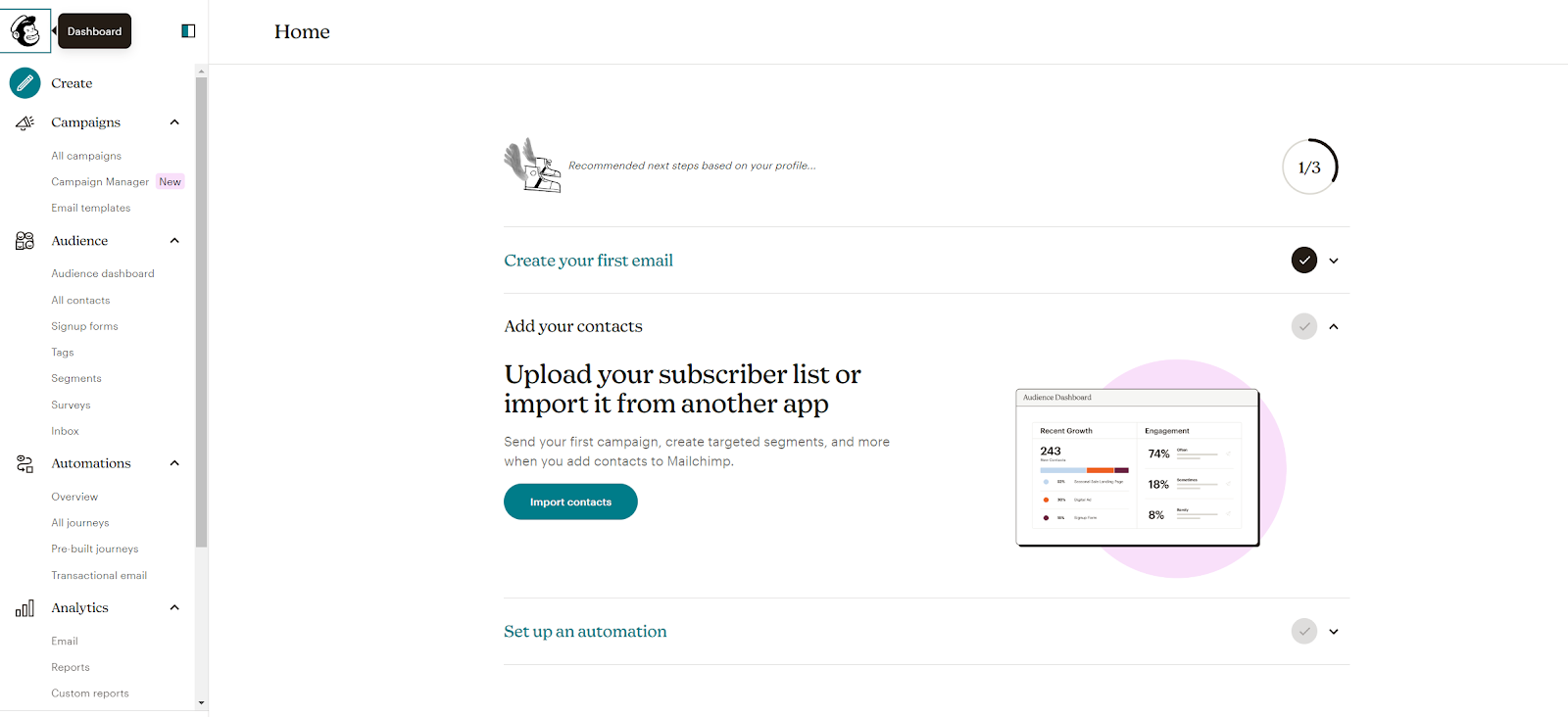
Everything is laid out in a straightforward and modern format, making it easy to find information about your audience, automation, and analytics without any confusion. Plus, you can search for help with anything you don’t understand from within your dashboard and find a host of articles and knowledgebase tools to assist you.
Klaviyo also keeps things relatively straightforward, with useful tooltips and pop-ups that appear when you’re browsing through your dashboard. You can click on the “Get Started” section of the platform for step-by-step instructions on how to set up your account and grow your audience.

Plus, the straightforward layout of the platform makes it relatively easy to find most things, like content templates, flows, and sign-up forms. However, because Klaviyo has a lot more options for customization than MailChimp, getting your entire campaign up and running can take a little more time and effort. The good news is that Klaviyo does have a lot of documentation available to help you if you get stuck. Plus, you can access the support team at any time.
Klaviyo vs. MailChimp: Integrations
For any modern business, integration is often essential when choosing the right email marketing platform. The good news is that both MailChimp and Klaviyo perform pretty well on this front. Both tools integrate with Zapier, so you can set up your own custom webhooks and connections.
Mailchimp allows you to add integrations to your dashboard quickly and seamlessly, with a dedicated marketplace where you can browse through native connections. There are hundreds of options to choose from, ranging from Facebook and Google Analytics to QuickBooks and Shopify.
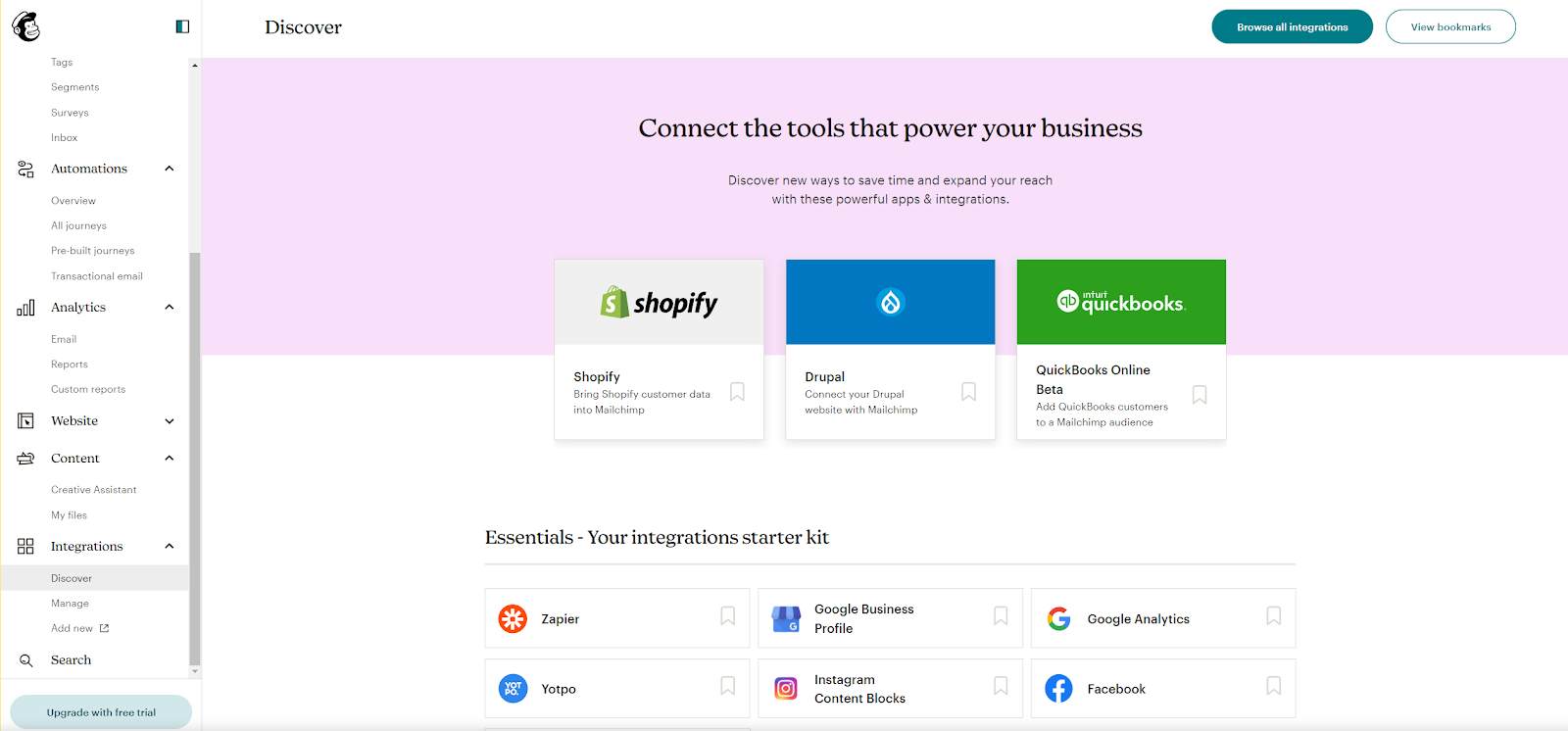
Integrations are also conveniently organized into sections, so you can quickly browse through the list and find different options for analytics, CRM connections, CMS solutions, and more.
Klaviyo also has hundreds of integrations available, although you’ll have to visit the Klaviyo website to find them rather than just adding them from your Klaviyo dashboard.
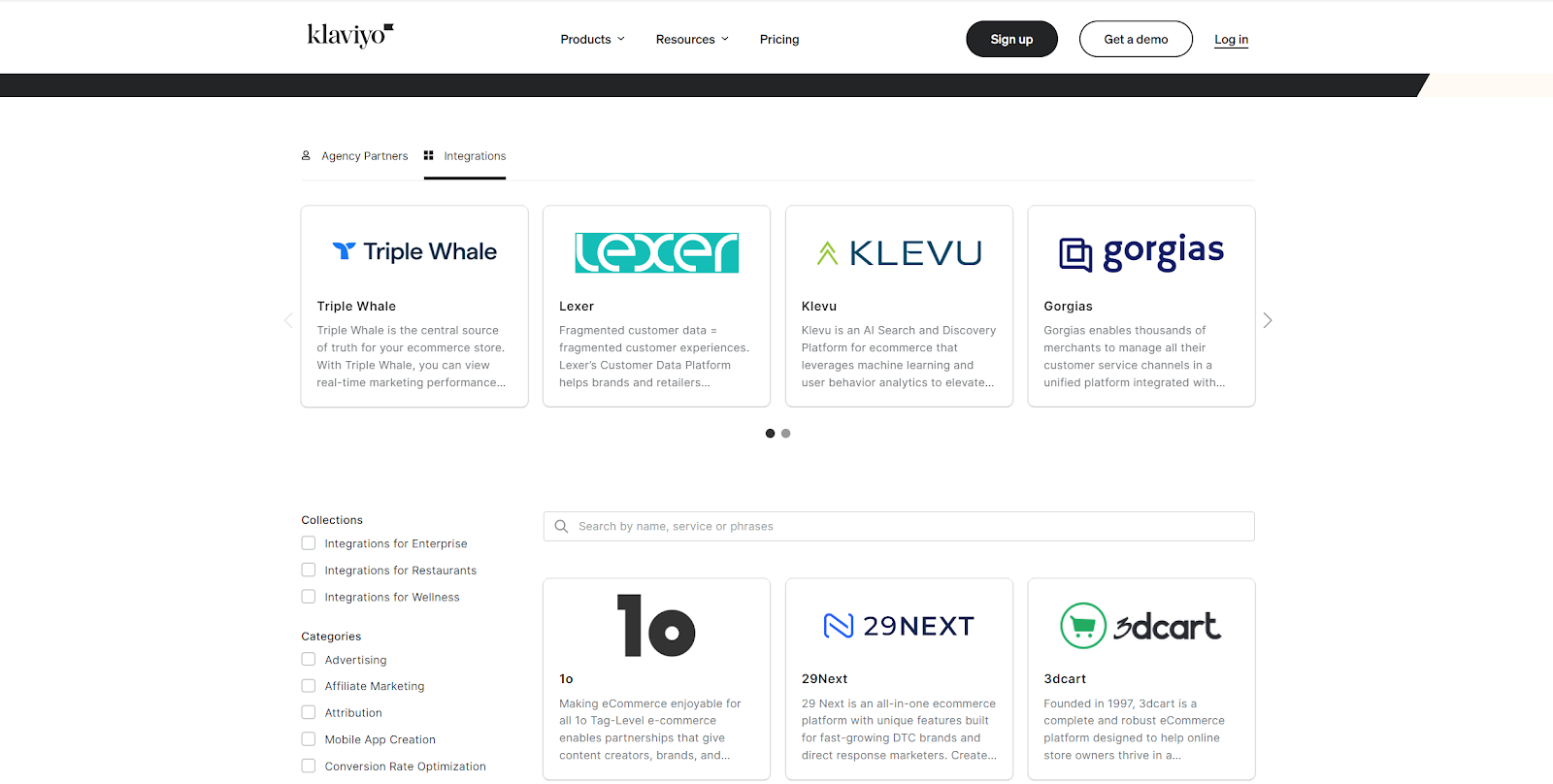
Once again, you can find options for everything from advertising to analytics, and everything is categorized with tags, so it’s easy to sort through all of your options. You can also build your own integrations and license third-party software through Klaviyo too.
Klaviyo vs. Mailchimp: Customer Support
Finally, let’s take a closer look at customer support. After all, we all need help sometimes. Klaviyo and MailChimp all make accessing self-service support quick and simple, with access to guides, webinars, videos, training sessions, and step-by-step guides. They also both offer numerous contact options if you need extra help with something specific.
Klaviyo’s help center includes access to a help center for guides and tutorials, the academy for Klaviyo courses, live training sessions, and a community forum. You can also chat with virtual assistants or request email support. However, support isn’t always available 24/7.
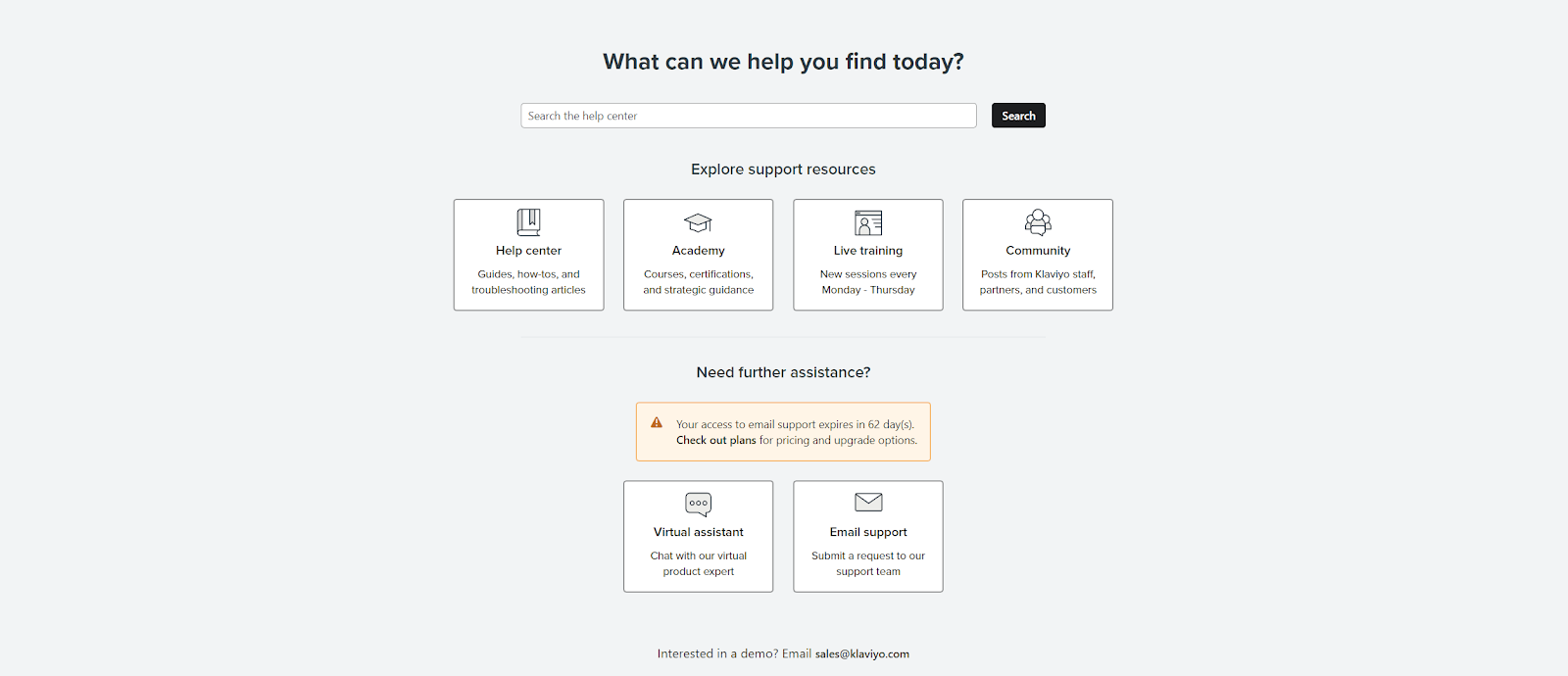
MailChimp offers 24/7 support to all customers on a paid plan. You’ll be able to contact the team via phone, email, or live chat, virtually whenever you like. What’s more, the help center is packed with tons of useful guidance in terms of articles and guides.

As mentioned above, you can also search for knowledgebase articles within your dashboard if you’re struggling with anything when making your own campaigns, which is handy. The biggest issue with MailChimp’s customer support is how limited it is for free plan users.
MailChimp vs. Klaviyo: Pros and Cons
Choosing between Klaviyo and MailChimp can be tough. Both of these tools are excellent solutions for companies investing in the email marketing space. They’re intuitive, feature-rich, and brimming with useful automation and analytics.
Mailchimp Pros:
- Extremely simple and straightforward backend
- Endless integration and add-on options
- AI enhancements to help you build your campaigns
- Fantastic thorough reporting options
- Excellent templates and designs
- Extra features for website building and advertising strategies
Mailchimp Cons:
- Extremely limited free plan
- Some issues with customer support
- No A/B testing on some packages
Mailchimp is likely to be the best option for you if you’re looking for a straightforward email marketing platform with plenty of integration options and a convenient backend. Mailchimp is easy to use and extremely flexible.
Klaviyo Pros:
- Lots of customization options for campaigns
- Robust integrations with a huge variety of tools
- Sophisticated automation with customizable rules
- Easy-to-use drag-and-drop automation builder
- Fantastic documentation and customer resources
- Powerful analytics and A/B testing on all plans
Klaviyo Cons:
- Slow customer support at times
- Steep learning curve for beginners
- Relatively expensive
Klaviyo is likely the best choice for you if you’re looking for advanced email marketing solutions with lots of customization options, in-depth analytics, and powerful A/B testing. If you have a higher budget, Klaviyo can give you access to more insights and support when it comes to connecting with your audience and generating sales.
Our Verdict
Ultimately, both MailChimp and Klaviyo are sure to offer a fantastic experience to anyone in search of a powerful email marketing tool. Generally, we’d recommend Klaviyo as the top option for companies in search of an advanced, feature-rich platform with excellent analytics tools, sophisticated marketing automation, and amazing customization options.
Alternatively, if you’re looking for something simple, straightforward, and flexible, MailChimp can be an ideal low-cost tool for marketing, with plenty of integrations to choose from and a wonderfully easy-to-use backend.



